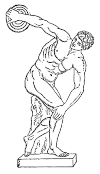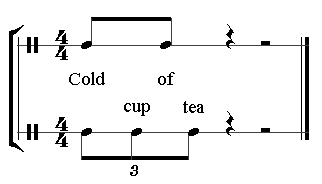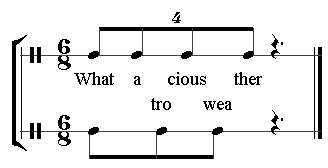The French phrase ouate de phoque (“seal’s cotton wool”) sounds like what the fuck in English.
For whatever that’s worth.
The French phrase ouate de phoque (“seal’s cotton wool”) sounds like what the fuck in English.
For whatever that’s worth.
Demetri Martin composed this palindromic poem as part of a project for a fractal geometry class at Yale in spring 1993. The first two and last two lines are palindromes, the middle line (“Be still if I fill its ebb”) minus its last letter is a palindrome, and the entire poem is a palindrome:
Dammit I’m mad
Evil is a deed as I live.
God, am I reviled?
I rise, my bed on a sun, I melt.
To be not one man emanating is sad. I piss.
Alas it is so late. Who stops to help? Man, it is hot.
I’m in it.
I tell.
I am not a devil.
I level “Mad Dog”.
Ah, say burning is as a deified gulp
in my halo of a mired rum tin.
I erase many men. Oh, to be man, a sin.
Is evil in a clam? In a trap?
No. It is open.
On it I was stuck.
Rats peed on hope.
Elsewhere dips a web.
Be still if I fill its ebb.
Ew, a spider … eh?
We sleep.
Oh no!
Deep, stark cuts saw it in one position.
Part animal, can I live? Sin is a name.
Both, one … my names are in it. Murder?
I’m a fool. A hymn I plug,
Deified as a sign in ruby ash – a Goddam level I lived at.
On mail let it in. I’m it.
Oh, sit in ample hot spots.
Oh, wet!
A loss it is alas (sip). I’d assign it a name.
Name not one bottle minus an ode by me:
“Sir, I deliver. I’m a dog.”
Evil is a deed as I live.
Dammit I’m mad.
“Improprieties in pronunciation” among the people of New England in 1808, collected by Caleb Bingham and published in The Child’s Companion:
afraid: afeard apron: apun audacious: outdacious bonfire: burnfire brittle: brickle cards: cairds caught: cotch coin: quine cucumber: cowcumber dictionary: dixonary drain: dreen earth: airth fanciful: fancical five pence: fippence gown: gound grasshopper: hoppergrass jaundice: janders musician: musicianer poplar: popple quart: quairt quotient: coshun sassafras: saxafax turtle: turcle tutor: tutorer umbrella: amberrillar Vermont: Vermount walnut: warnut watermelon: watermillion
“It is not to be supposed that they are all in common use in every part of New England. Some of them are local. In general, however, they are used more or less in all the New England States.”

When I went out to throw the discus
I went and sprained some little viscus.
Since that disruption of my viscera
I don’t go out and throw the discera.
— Don Laycock
subagitate
v. to have sex with
verecund
adj. bashful; modest
reme
v. to cry or call out
cacoëpistic
adj. badly pronounced
[Sir Walter Raleigh] loved a wench well; and one time getting up one of the Mayds of Honour up against a tree in a Wood (’twas his first Lady) who seemed at first boarding to be something fearfull of her Honour, and modest, she cryed, sweet Sir Walter, what doe you me ask? Will you undoe me? Nay, sweet Sir Walter! Sweet Sir Walter! Sir Walter! At last, as the danger and the pleasure at the same time grew higher, she cryed in the extasey, Swisser Swatter Swisser Swatter. She proved with child, and I doubt not but this Hero tooke care of them both, as also that the Product was more than an ordinary mortal.
— John Aubrey, Brief Lives, 1697
In his 1954 book Language in Relation to a Unified Theory of the Structure of Human Behavior, Kenneth Pike presents a toy language in which meaning is determined by the relative order of the elements. If these expressions have the indicated meanings:
1. los "It is smoke"
2. mif "It is a ball"
3. kap "They are eyes"
4. losmif "The ball is smoking"
5. miflos "The smoke is rolling"
6. mifmif "The ball is rolling"
7. mifmiflos "The smoke is rolling in round puffs"
8. mifmifkap "He is rolling his eyes around" or
"The eyes are rolling around"
9. losmifkap "His eyes roam darkly"
10. mifkaplos "The smoke is trying to escape" or
"The smoke looks around"
11. kapmifmif "I can see the ball rolling"
12. mifkapkap "He is looking around"
13. losloskap "His eyes are smoldering menacingly"
… what would be meant by kapmiflos and kapkapkap?
“Conjugated nouns,” offered by Ohio State University linguist Arnold M. Zwicky in Verbatim in 1975:
I steal the keel. I stole the coal. I have stolen the colon.
They choose the hues. They chose the hose. They have chosen the hosen.
They mow the banks of the row. They mowed the banks of the road. They have mown the banks of the Rhone.
I do it with the buoys. I did it with the biddies. I have done it with the bunnies.
Mike Anglin took this up in Word Ways in 1988:
I tear the hair; I tore the whore; I have torn the horn.
I see the sea; I saw the saw; I have seen the scene.
I draw the law; I drew the loo; I have drawn the lawn.
I throw the bow; I threw the boo; I have thrown the bone.
I sink the mink; I sank the manque; I have sunk the monk.
I choose the booze; I chose the bows; I have chosen the bosun.
I weave the leaves; I wove the loaves; I have woven the love-ins.
I forsake the cake; I forsook the cook; I have forsaken the whole mess.
Philip M. Cohen added, “I scare for the mare; I score for the more; I have scorn for the morn.”
“Ingliz menuyu” presented to writer William Dalrymple at a family restaurant in Turkey in 1986:
SOAP
Ayas soap
Turkish tripte soap
Sheeps foot
Macaront
Water pies
EATS FROM MEAT
Deuner kepab with pi
Kebap with green pe
Kebap in paper
Meat pide
Kebap with mas patato
Samall bits of meat grilled
Almb chops
VEGETABLES
Meat in earthenware stev pot
Stfue goreen pepper
Stuffed squash
Stuffed tomatoes z
Stuffed cabbages lea
Leek with finced meat
Clery
SALAD
Brain salad
Cacik — a drink made ay ay
And cucumber
FRYING PANS
Fried aggs
Scram fried aggs
Scrum fried omlat
Omlat with brain
SWEETS AND RFUITS
Stewed atrawberry
Nightingales nests
Virgin lips
A sweet dish of thinsh of batter with butter
Banane
Meon
Leeches
“It was a difficult choice,” he writes. From In Xanadu, 1989.

Wikimedia user Tarquin points out that the natural rhythm of spoken language can be used to teach polyrhythms.
Above: The phrase “cold cup of tea,” spoken naturally, approximates a rhythm of 2 against 3.
Below: The phrase “what atrocious weather” approximates 4 against 3.
